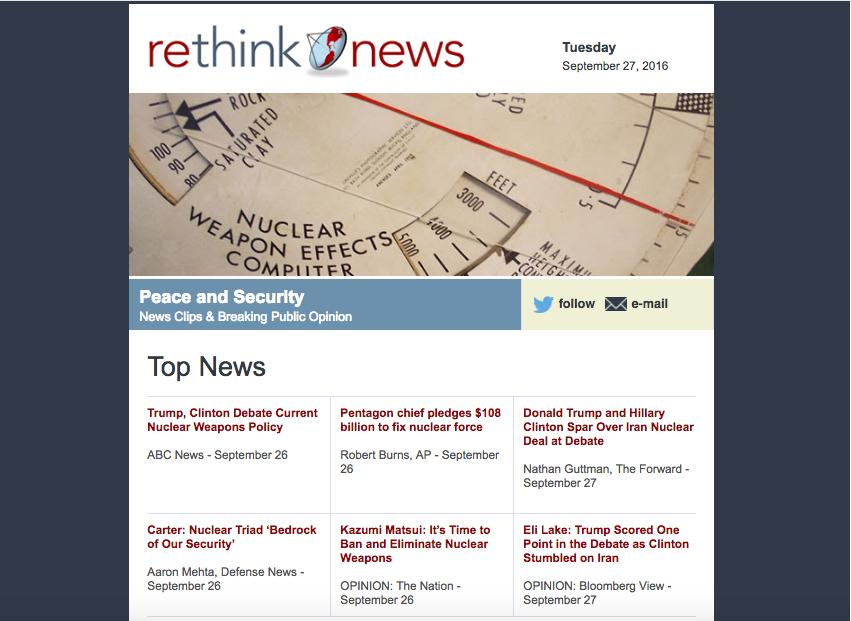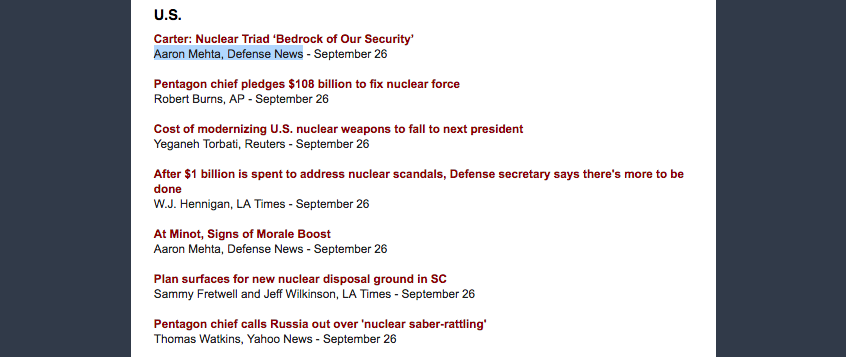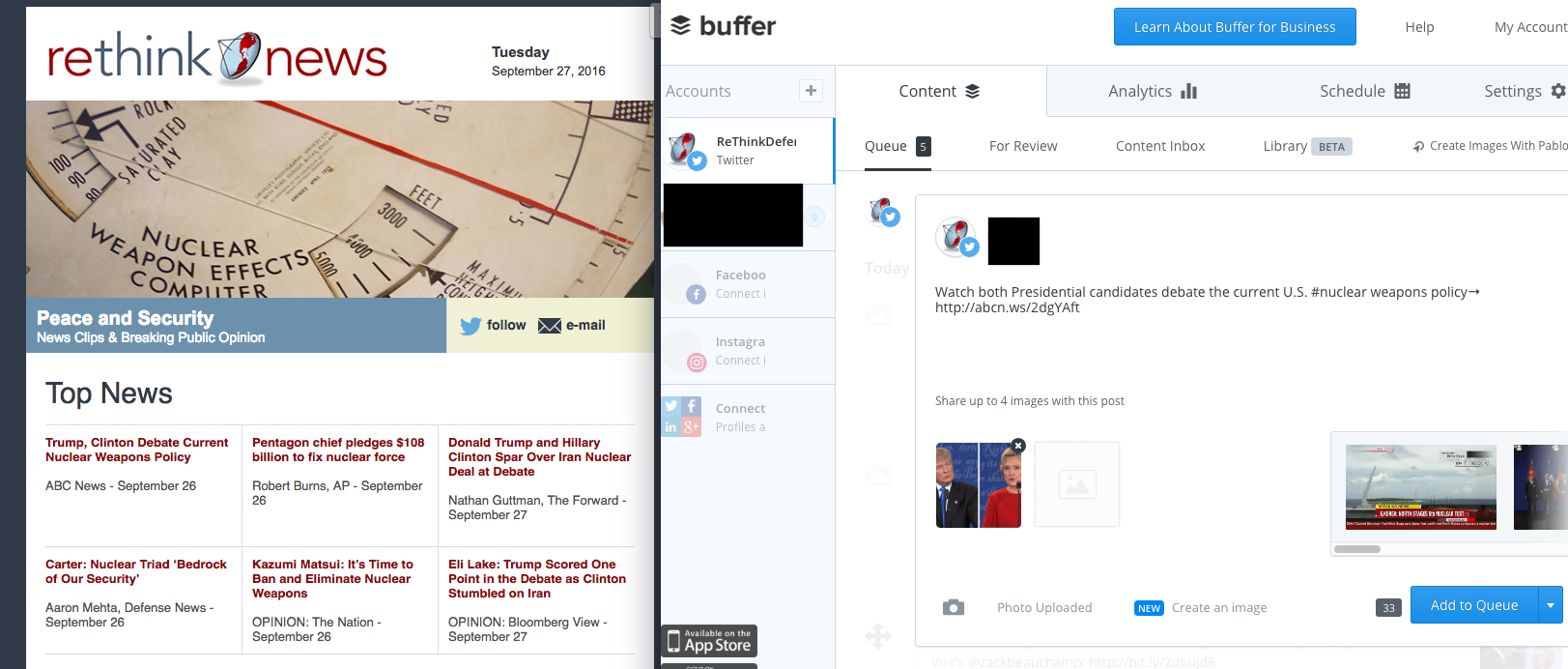
How to Use Our Morning Clips to Shape Your Media Work
If you have been involved with ReThink Media, chances are that you receive the daily news clips that we send out in the morning (if you don’t, you should, so make sure to reach out to your ReThink Media point of contact!).
These daily clips, compiled by ReThink staff, are designed to highlight the most important issue-related news developments over the last 24-hours. But beyond providing you a download of which news stories, opinion pieces, and editorials community members should be aware of, these clips are also incredibly useful when it comes to informing your daily and long-term strategy.
Wondering what I mean?
I’ll explain in detail below, but the clips can definitely help you:
- Understand the media landscape.
- Schedule social media content.
- Highlight community work.

Understanding the Media Landscape
I mentioned this in an earlier post about Twitter lists and how to use them, but understanding the broader media landscape is vital when it comes to immediate and long-term strategy. Knowing what the media environment around your issue is, how breaking news developments change that environment, and what shifts are occurring in public discourse are all essential when deciding what you’re going to say and when.
Reporters
The media landscape has shifted dramatically (see this great breakdown by John Oliver) in the last decade as fewer reporters are expected to do more. This means that reporters are not only shifting from one outlet to another, but also constantly changing their focus and story angle.
Each entry in our morning clips deliberately includes the name of the reporter(s) listed in the byline when possible. Why? This allows members of the community to see not only who is writing on their issues, but also from what angle and with what frequency.

For example, when building a press list or drafting a pitch, the clips should be one of your first stops to better tailor your outreach. Using the clips, you can see whether a reporter has appeared in them recently (thus, is writing about our issues), what topic(s) they wrote about, and what angle they covered. This all helps you pitch the right journalists with the best intelligence.
Conversely, if a reporter who was previously active writing on a set of issues is now no longer showing up the clips, that also warrants a follow up: did they leave the beat? Are they taking a break? All of this will make your outreach more effective, as journalists are likely going to ignore (or block) those who send information that’s irrelevant to their current work.
For instance, as the debate around the Iran nuclear deal developed into a more prominent national story, the names of reporters who had not previously covered the negotiations started appearing in the clips. Some were reporting on developments from the White House, in U.S. Congress, or among foreign governments, while other reporters began examining its potential effect on the Iranian-American community, American Jewish community, and the larger ramifications of diplomatically re-engaging governments.
As the universe of reporters who covered the nuclear deal expanded, we realized that we needed to add these reporters to our various lists for outreach.
In addition, since these reporters were relatively new to a fairly technical and complex topic, we knew they might find additional background resources and expert introductions useful.
Outlets
While we include the names of individual reporters in our morning clips, we also include the name of the outlet for each story. Seems to be common sense, right? Of course you’d want to credit the outlet.
But this becomes particularly important when it comes to stories – perhaps about the same topic – that are written by wire services like the Associated Press but hosted by individual newspapers.

Wire services like the Associated Press, Agence France Press, and Reuters have their own reporting staffs that write and publish stories. When these stories are complete, they are posted on both the individual services’ own website and across multiple newspapers. If you don’t pay attention while reading, it can be easy to assume that a story written by the Associated Press was actually by the Washington Post, simply because the story was on the Washington Post website.
Why is this important? Because stories by wire services have a massive distribution nationwide and are used by other journalists in their own reporting. If there is a major development in a wire story, you can be sure a lot of people will see it that, and that you’ll need to respond.
Understanding the differences in outlets and their editorial coverage of a topic is necessary when reaching out to that outlet’s reporters and editors. This helps you to understand what the audiences are of a particular newspaper, where that institution might stand on your topic, and even what kind of opinion piece they might be likely to accept.
Correcting the Record
Advocates who work in a given field are often more knowledgeable about the details and nuances of the issues than anyone else. Chances are that at some point, a journalist may make a factual error in understanding an issue you work on.

Our morning clips not only compile multiple stories about the same topic together, but also provide an avenue to make sure you aren’t missing an incorrect statement by accident. (P.S. We always suggest being respectful when you reach out to offer clarification. In fact, here’s a whole blog post about how to correct a reporter without ruining your relationship.)
Reporter Shout-Outs
Journalists have a difficult, high stress and often underappreciated job. A simple “thank you” to them for quoting you in a piece or acknowledgement of a job well done goes a long way toward building some respect and, potentially, a more positive relationship. (Did you see our blog post about how to use Twitter to build relationships with reporters? Giving reporters a shout out online can lead to them writing about you again in the future!)
Social Media Content
When it comes to social media content, the best way to build a base of followers is to post consistently throughout the day (and even overnight). However, as we well know, sometimes coming up with that much original content can be difficult.
Our morning clips are a great resource to pull from – especially with Buffer, Tweetdeck, or HootSuite that allow you to schedule tweets ahead of time – to create your content.

You can simply tweet the top stories, or better yet, add your own unique perspective to them to be an additional resource for reporters. Consider what value you can add to the conversation.
Highlighting Community Work
In issue advocacy, the community of nonprofit organizers and experts is usually comparatively small.
This makes it more important than ever that organizations promote and share great work by others done in the community.
The clips are a great way to see pieces written by friends and colleagues (and a good prompt to be sure to share those pieces).


This helps to expand the impact of colleagues, sometimes to a whole new audience, and can help raise awareness to your issue and take it to the next level.
How have you used our morning clips to inform your media and communication strategy? Tweet to us @rethink_media and let us know!



